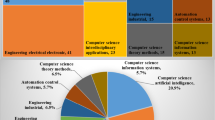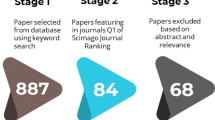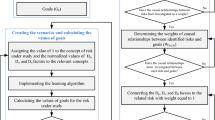Abstract
The lives of humans working in hazardous fields are often at risk. Therefore, replacing humans with robots can help to reduce the mortality rate. Hence, this work considers four dangerous operations, namely, earthquake rescue, fire rescue, water rescue and bomb disposal operation, and determines the most wanted field for the replacement of robots concerning their death rate. The fields’ prioritization is examined using multi-criteria decision-making (MCDM) models. Since the alternatives (fields) lack information with respect to the criteria, this work utilizes the sub-alternatives (field performer) to fill in the information of the alternatives in order to prioritize the fields and detect the impact of the robots in the field. When uncertainty prevails in crisp data, the MCDM methods are generally considered in a fuzzy environment. The intuitionistic trapezoidal dense fuzzy (ITpDF) set which is one of the extensions of fuzzy set is dealt here. Considering the MCDM models such as extended PSI, COCOSO, PIV and MARCOS in the ITpDF field, the integrated ITpDF–PSI–COCOSO–PIV–MARCOS model is framed, where the final ITpDF score values from each considered models are aggregated using the Bonferroni mean aggregation method. The aggregated ITpDF score values are defuzzified and ranked using the novel ITpDF incircle ranking. The result reveals that earthquake rescue robots have a lesser impact compared to robots utilized in bomb disposal operations. Finally, the sensitivity and comparative analysis are performed to find the effectiveness of the model and the quality of the outcome, respectively.









Similar content being viewed by others
Explore related subjects
Discover the latest articles, news and stories from top researchers in related subjects.Data Availability
The corresponding author can provide the datasets employed in work upon reasonable request.
References
Bashir, M.O.I.: Application of artificial intelligence (AI) in dredging efficiency in Bangladesh. Ann. Emerg. Technol. Comput. 6(1), 74–88 (2022)
Canbolat, H. (Ed.).: Robots operating in hazardous environments. BoD-Books on Demand (2017)
Bahalla, A.: Accidental Deaths and Suicides in India 2021, pp. 1–298. National Crime Records Bureau, New Delhi (2021)
Swethaa, S., Felix, A.: An intuitionistic dense fuzzy AHP-TOPSIS method for military robot selection. J. Intell. Fuzzy Syst. 44(4), 6749–6774 (2023)
Bottou, L.: Stochastic gradient descent tricks. In: Neural Networks: Tricks of the Trade, 2nd edn., pp. 421–436. Berlin, Heidelberg, Springer, Berlin Heidelberg (2012)
Holland, J.H.: Genetic algorithms. Sci. Am. 267(1), 66–73 (1992)
Marini, F., Walczak, B.: Particle swarm optimization (PSO). A tutorial. Chemom. Intell. Lab. Syst. 149, 153–165 (2015)
Dorigo, M., Stützle, T.: Ant Colony Optimization: Overview and Recent Advances, pp. 311–351. Springer International Publishing (2019)
De, S.K.: The goat search algorithms. Artif. Intell. Rev. 56(8), 8265–8301 (2023)
Felix, A., Dash, S.K.: Haar FCM with DEMATEL technique to analyze the solid waste management. In: Advances in Smart Grid Technology: Select Proceedings of PECCON 2019(2), 393-402. Springer Singapore (2021)
Devi, S.A., Felix, A., Narayanamoorthy, S., Ahmadian, A., Balaenu, D., Kang, D.: An intuitionistic fuzzy decision support system for COVID-19 lockdown relaxation protocols in India. Comput. Electr. Eng. 102, 108166 (2022)
Kang, D., Devi, S.A., Felix, A., Narayanamoorthy, S., Kalaiselvan, S., Balaenu, D., Ahmadian, A.: Intuitionistic fuzzy MAUT-BW Delphi method for medication service robot selection during COVID-19. Op. Res. Perspect. 9, 100258 (2022)
Nithyanandham, D., Augustin, F., Micheal, D.R., Pillai, N.D.: Energy based bipolar intuitionistic fuzzy digraph decision-making system in selecting COVID-19 vaccines. Appl. Soft Comput. 147, 110793 (2023)
Nithyanandham, D., Augustin, F., Narayanamoorthy, S., Ahmadian, A., Balaenu, D., Kang, D.: Bipolar intuitionistic fuzzy graph based decision-making model to identify flood vulnerable region. Environ. Sci. Pollut. Res. 30(60), 125254–125274 (2023)
Nithyanandham, D., Augustin, F.: A bipolar fuzzy p-competition graph based ARAS technique for prioritizing COVID-19 vaccines. Appl. Soft Comput. 146, 110632 (2023)
Zadeh, L.A.: Fuzzy sets. Inform Control 8(3), 338–353 (1965)
Dijkman, J.G., Van Haeringen, H., De Lange, S.J.: Fuzzy numbers. J. Math. Anal. Appl. 92(2), 301–341 (1983)
Atanassov, K.: Intuitionistic fuzzy sets. Fuzzy Sets Syst. 20(1), 87–96 (1986)
De, S.K., Beg, I.: Triangular dense fuzzy sets and new defuzzification methods. J. Intell. Fuzzy Syst. 31(1), 469–477 (2016)
De, S.K.: Triangular dense fuzzy lock sets. Soft. Comput. 22, 7243–7254 (2018)
Swethaa, S., Felix, A.: Various defuzzification methods for trapezoidal dense fuzzy sets. Adv. Math. Sci. J. 10, 251–258 (2021)
Maity, S., De, S.K., Mondal, S.P.: A study of a backorder EOQ model for cloud-type intuitionistic dense fuzzy demand rate. Int. J. Fuzzy Syst. 22, 201–211 (2020)
Sampathkumar, S., Augustin, F., Kaabar, M.K., Yue, X.G.: An integrated intuitionistic dense fuzzy Entropy-COPRAS-WASPAS approach for manufacturing robot selection. Adv. Mech. Eng. 15(3), 16878132231160264 (2023)
Maniya, K., Bhatt, M.G.: A selection of material using a novel type decision-making method: preference selection index method. Mater. Des. 31(4), 1785–1789 (2010)
Attri, R., Grover, S.: Application of preference selection index method for decision making over the design stage of production system life cycle. J. King Saud Univ.-Eng. Sci. 27(2), 207–216 (2015)
Yazdani, M., Zarate, P., Kazimieras Zavadskas, E., Turskis, Z.: A combined compromise solution (CoCoSo) method for multi-criteria decision-making problems. Manag. Decis. 57(9), 2501–2519 (2019)
Qiyas, M., Naeem, M., Khan, S., Abdullah, S., Botmart, T., Shah, T.: Decision support system based on CoCoSo method with the picture fuzzy information. J. Math. 2022, 1–11 (2022)
Das, P.P., Chakraborty, S.: SWARA-CoCoSo method-based parametric optimization of green dry milling processes. J. Eng. Appl. Sci. 69(1), 1–21 (2022)
Peng, X., Zhang, X., Luo, Z.: Pythagorean fuzzy MCDM method based on CoCoSo and CRITIC with score function for 5G industry evaluation. Artif. Intell. Rev. 53(5), 3813–3847 (2020)
Mufazzal, S., Muzakkir, S.M.: A new multi-criterion decision making (MCDM) method based on proximity indexed value for minimizing rank reversals. Comput. Ind. Eng. 119, 427–438 (2018)
Khan, N.Z., Ansari, T.S.A., Siddiquee, A.N., Khan, Z.A.: Selection of E-learning websites using a novel Proximity Indexed Value (PIV) MCDM method. J. Comput. Educat. 6, 241–256 (2019)
Stević, Ž, Pamučar, D., Puška, A., Chatterjee, P.: Sustainable supplier selection in healthcare industries using a new MCDM method: measurement of alternatives and ranking according to COmpromise solution (MARCOS). Comput. Ind. Eng. 140, 106231 (2020)
Duc Trung, D.: Multi-criteria decision making under the MARCOS method and the weighting methods: applied to milling, grinding and turning processes. Manuf. Rev. 9, 3 (2022)
Bonferroni, C.: Sulle medie multiple di potenze. Boll. Un. Mat. Ital. 5(3–4), 267–270 (1950)
Yager, R.R.: On generalized Bonferroni mean operators for multi-criteria aggregation. Int. J. Approx. Reason. 50(8), 1279–1286 (2009)
Xu, Z., Yager, R.R.: Intuitionistic fuzzy Bonferroni means. IEEE Trans Syst. Man Cyber. Part B (Cybernetics) 41(2), 568–578 (2010)
Zhou, W., He, J.M.: Intuitionistic fuzzy normalized weighted Bonferroni mean and its application in multicriteria decision making. J. Appl. Math., 2012 (2012)
He, Y., He, Z., Wang, G., Chen, H.: Hesitant fuzzy power Bonferroni means and their application to multiple attribute decision making. IEEE Trans. Fuzzy Syst. 23(5), 1655–1668 (2014)
He, Y., He, Z., Chen, H.: Intuitionistic fuzzy interaction Bonferroni means and its application to multiple attribute decision making. IEEE Trans. Cyber. 45(1), 116–128 (2014)
He, Y., He, Z.: Extensions of Atanassov’s intuitionistic fuzzy interaction bonferroni means and their application to multiple-attribute decision making. IEEE Trans. Fuzzy Syst. 24(3), 558–573 (2015)
Garg, H., Arora, R.: Bonferroni mean aggregation operators under intuitionistic fuzzy soft set environment and their applications to decision-making. J. Op. Res. Soc. 69(11), 1711–1724 (2018)
Kaur, G., Garg, H.: Multi-attribute decision-making based on Bonferroni mean operators under cubic intuitionistic fuzzy set environment. Entropy 20(1), 65 (2018)
Verma, R., Merigó, J. M., Mittal, N.: Triangular Fuzzy Partitioned Bonferroni Mean Operators and Their Application to Multiple Attribute Decision Making. In: 2018 IEEE Symposium Series on Computational Intelligence (SSCI) (pp. 941-949). IEEE (2018)
Verma, R., Merigó, J. M.: On generalized intuitionistic fuzzy interaction partitioned bonferroni mean operators. In: 2019 IEEE International Conference on Fuzzy Systems (FUZZ-IEEE) (pp. 1-6). IEEE (2019)
Yang, W., Pang, Y.: New \(q\)-rung orthopair fuzzy Bonferroni mean Dombi operators and their application in multiple attribute decision making. IEEE Access 8, 50587–50610 (2020)
Mahmood, T., Ali, Z., Rehman, U.U., Aslam, M.: An advanced study on the Bonferroni mean operators for managing cubic intuitionistic complex fuzzy soft settings and their applications in decision making. IEEE Access 10, 58689–58721 (2022)
Chakraborty, S., Saha, A.K.: Novel Fermatean Fuzzy Bonferroni Mean aggregation operators for selecting optimal health care waste treatment technology. Eng. Appl. Artif. Intell. 119, 105752 (2023)
Mahmood, T., Rehman, U.U., Naeem, M.: Dombi Bonferroni mean operators under bipolar complex fuzzy environment and their applications in internet world. IEEE Access 11, 22727–22755 (2023)
Luukka, P., Collan, M.: Bonferroni mean based similarity based TOPSIS. In: 2016 IEEE International Conference on Fuzzy Systems, 704–709 (2016)
Garg, H., Agarwal, N., Tripathi, A.: Choquet integral-based intuitionistic fuzzy Bonferroni mean operator. In 2016 Ninth International Conference on Contemporary Computing (IC3) 1–4 (2016)
Das, S., Guha, D., Mesiar, R.: Extended Bonferroni mean under intuitionistic fuzzy environment based on a strict t-conorm. IEEE Trans. Syst. Man Cyber.: Syst. 47(8), 2083–2099 (2016)
Liu, P., Liu, J., Chen, S.M.: Some intuitionistic fuzzy Dombi Bonferroni mean operators and their application to multi-attribute group decision making. J. Op. Res. Soc. 69(1), 1–24 (2018)
Mesiarová-Zemánková, A., Kelly, S., Ahmad, K.: Bonferroni mean with weighted interaction. IEEE Trans. Fuzzy Syst. 26(5), 3085–3096 (2018)
Zhao, H.: Multiattribute decision-making method with intuitionistic fuzzy Archimedean Bonferroni means. Math. Probl. Eng. 2021, 1–24 (2021)
Jabeen, K., Khan, Q., Ullah, K., Senapati, T., Moslem, S.: An Approach to MADM based on Aczel-Alsina Power Bonferroni Aggregation Operators for \(q\)-rung Orthopair Fuzzy Sets. IEEE Access (2023)
Liu, L., Wu, X., Chen, G.: Picture fuzzy interactional Bonferroni mean operators via strict triangular norms and applications to multi-criteria decision making. IEEE Trans. Fuzzy Syst.(2023)
Nixon, J.D., Dey, P.K., Davies, P.A.: Which is the best solar thermal collection technology for electricity generation in north-west India? Evaluation of options using the analytical hierarchy process. Energy 35(12), 5230–5240 (2010)
Adar, E., Karatop, B., Bilgili, M.S., İnce, M.: Prioritization of the treatment and disposal methods of wastes containing polychlorinated biphenyl by fuzzy multi-criteria decision-making and risk assessment. Environ. Monit. Assess. 192, 1–15 (2020)
Almohaimeed, A.S., Suryanarayanan, S., O’Neill, P.: Reducing carbon dioxide emissions from electricity sector using demand side management, pp. 1–21. Recovery, Utilization, and Environmental Effects, Energy Sources, Part A (2021)
Mandavgade, N.K., Kalbande, V.N., Bilawane, R.R., Kanojiya, M.T., Padole, C.U.: AHP for ranking effect of qualitative factors in uncertainty measurement of material testing. Mater. Today: Proc. 46, 7921–7925 (2021)
Zafaranlouei, N., Ghoushchi, S.J., Haseli, G.: Assessment of sustainable waste management alternatives using the extensions of the base criterion method and combined compromise solution based on the fuzzy Z-numbers. Environ. Sci. Pollut. Res. 30(22), 62121–62136 (2023)
Shannon, C.E., Weaver, W.: The Mathematical Theory of Communication, p. 1947. University of Illinois Press, Urbana (1947)
Kaufmann, A.: Introduction to the Theory of Fuzzy Subsets. Academic press, Cambridge (1975)
Jain, R.: Decision making in the presence of fuzzy variables. IEEE Trans. Syst. Man Cybern. 6(10), 698–703 (1976)
Akyar, E., Akyar, H., Düzce, S.A.: A new method for ranking triangular fuzzy numbers. Int. J. Uncertain. Fuzziness Knowled.-Based Syst. 20(05), 729–740 (2012)
Earthquake rescue robot: https://www.robot-magazine.fr/robot-serpent-sauver-vies/
Earthquake rescue robot: https://www.army.mil/article/48456/robots_to_rescue_wounded_on_battlefield
Firefighter robot: https://www.emicontrols.com/en/fire/mobile-products/firefighting-robot-taf60-taf60x/
Water rescue robot: https://www.coolthings.com/emily-the-robot-lifeguard-to-the-rescue/
Bomb disposal robot: https://depositphotos.com/221828934/stock-photo-bomb-disposal-robot-bomb-rendering.html
Coburn, A. W., Spence, R. J., Pomonis, A.: Factors determining human casualty levels in earthquakes: mortality prediction in building collapse. In: Proceedings of the tenth world conference on Earthquake Engineering (Vol. 10, pp. 5989-5994). Balkema Rotterdam (1992)
Wyss, M., Speiser, M., Tolis, S.: Earthquake fatalities and potency. Nat. Hazards 119(2), 1091–1106 (2022)
Winberg, D.: International fire death rate trends (2016)
Sanghavi, P., Bhalla, K., Das, V.: Fire-related deaths in India in 2001: a retrospective analysis of data. The Lancet 373(9671), 1282–1288 (2009)
Fire Death and Injury Risk - US Fire Administration: https://www.usfa.fema.gov/statistics/deaths-injuries/#:~:text=U.S.%20overall%20fire%20death%20rate%20trend&text=In%202021%2C%20the%20fire%20death,11.4%20deaths%20per%20million%20population
Peden, M.M., McGee, K.: The epidemiology of drowning worldwide. Inj. Control Saf. Promot. 10(4), 195–199 (2003)
Lin, C.Y., Wang, Y.F., Lu, T.H., Kawach, I.: Unintentional drowning mortality, by age and body of water: an analysis of 60 countries. Inj. Prev. 21(e1), e43–e50 (2014)
Kemp, A.F.: Explosive remnants of war: a case study of explosive ordnance disposal in Laos, 1974-2013 (Doctoral dissertation, University of Greenwich) (2014)
Funding
Not applicable.
Author information
Authors and Affiliations
Corresponding author
Ethics declarations
Conflict of interest
There are no competing interests of the authors.
Appendix
Appendix
See Tables 14, 15, 16, 17 and 18.
The abbreviations are given in Table 19.
Rights and permissions
Springer Nature or its licensor (e.g. a society or other partner) holds exclusive rights to this article under a publishing agreement with the author(s) or other rightsholder(s); author self-archiving of the accepted manuscript version of this article is solely governed by the terms of such publishing agreement and applicable law.
About this article
Cite this article
Sampathkumar, S., Augustin, F. Optimizing Robot Deployment in Hazardous Environment: MCDM Approach Using Field Performers Under Intuitionistic Dense Fuzzy Set. Int. J. Fuzzy Syst. 26, 1537–1566 (2024). https://doi.org/10.1007/s40815-024-01688-1
Received:
Revised:
Accepted:
Published:
Issue Date:
DOI: https://doi.org/10.1007/s40815-024-01688-1




